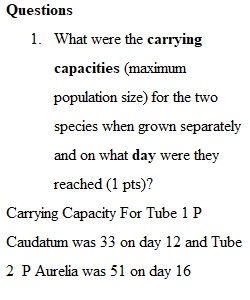


Q DOWNLOAD THE UNIT 8 EXPERIMENT ANSWER SHEET!Download DOWNLOAD THE UNIT 8 EXPERIMENT ANSWER SHEET! How to Proceed • Read through the introductory materials below. • Open the Unit 8 Experiment Answer Sheet and complete the following Experiment exercises this unit: o Experiment 8 Exercise 1 - Species Interactions: Competition (~1.5 hrs) o Experiment 8 Exercise 2 - Biomes (~30 min) • Save your completed Unit 8 Experiment Answer Sheet and submit it no later than Sunday midnight (CT). ________________________________________ Species Interactions: Competition - Introduction This unit we are learning about species-species interactions and how species influence each other (see pp 428-432 and our online lecture). One important interaction is interspecific competition, in which two or more species compete for limited resources. Competition, along with predation and symbioses (e.g., commensalism, mutualism, and parasitism) are important biological interactions that affect the size of species populations. In the first exercise, we will examine the population growth of two species of freshwater ciliates. Populations of these species initially grow exponentially (see p 408), but the population does not increase in size forever. Eventually it reaches what is known as the carrying capacity of the environment, or the maximum population size the environment can support due to limitations in food, water or other resources. Competitive exclusion (see p 429) may occur between two species that compete for the same resources. In this situation, only one species will be successful, such that the other species is forced to move elsewhere or die out. This rarely happens in nature though, since the species on the losing end typically switches to an alternate resource. However, under artificial situations, elimination of one species can occur. The purpose of this exercise is to use a simulation to model competitive exclusion using the microscopic organisms that Gause used to come up with his competitive exclusion principle (see p 429). You will need to use the following website. Be sure you can access it and use it: Glencoe/McGraw Hill. No date. Population Biology http://www.mhhe.com/biosci/genbio/virtual_labs/BL_04/BL_04.htmlLinks to an external site. When you are ready to begin, go to the above website and open the Unit 8 Experiment Answer Sheet and follow the instructions. ________________________________________ In Biomes - Introduction This unit we have learned about the large scale ecosystems called Biomes. They have developed over millions of years and the flora and fauna found in each biome type have adapted to the long term climate conditions (e.g., average rainfall, average temperatures). The purpose of this exercise is to see how well you understand the biotic and abiotic factors that shaped the various biomes. Review pp 384-390 and our online lecture this unit before beginning. You will need to use the following websites. Be sure you can access them and use them: NASA. No date. The Great Graph Match http://earthobservatory.nasa.gov/Experiments/Biome/graphmatch_advanced.php Links to an external site. NASA. No date. To Plant or Not to Plant http://earthobservatory.nasa.gov/Experiments/Biome/plant_it.phpLinks to an external site. When you are ready to begin, open the Unit 8 Experiment Answer Sheet to complete this exercise. ________________________________________ Unit 8 Experiment Grading Rubric Component Expectation Points Experiment 8 Exercise 1 Correctly conducts experiment, records data and generates graphs. 8 pts Experiment 8 Exercise 1 Demonstrates an understanding competition between species and the effect it has on population growth (Questions 1-4). 8 pts Experiment 8 Exercise 2 Develops an appreciation of the diversity of ecosystems around the globe and understands the environmental conditions that lead to their development. 10 pts TOTAL [[[[[[[ 26 pts PreviousNext
View Related Questions